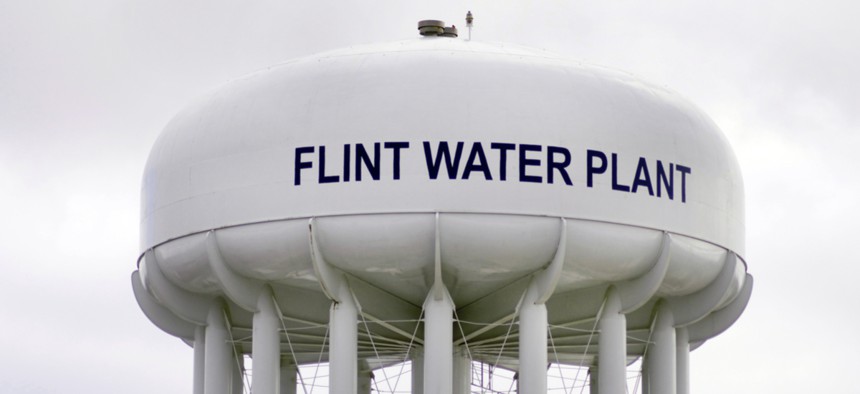Delayed EPA Response to Water Crisis Increased Health Risks to Flint Residents, IG Finds

A new EPA inspector general report faults the agency in its response to the Flint water crisis. Shutterstock

Connecting state and local government leaders
A new watchdog report found that the federal agency's regional office didn't establish clear roles for the state environmental agency and failed to create clear lines of communication.
The Environmental Protection Agency made a series of errors and oversights in reaction to contamination of drinking water in Flint, Mich., according to a new watchdog report that primarily faulted regional leadership for failing to properly recognize and respond to the gravity of the situation in a timely manner.
While the major decisions that led to the contamination were made at the state level—including the initial decision to switch Flint’s water source from Detroit’s supply to the Flint River—the EPA inspector general identified a slew of deficiencies at EPA. The agency’s Region 5 never established clear roles and responsibilities with the Michigan Department of Environmental Quality and failed to create clear lines of communication, the IG said.
An EPA contractor in 2010 identified problems with MDEQ’s disinvestments in water safety, but EPA never took action to intervene. EPA managers told the IG they informed MDEQ to pursue consistent corrosion control treatment as early as 2015, but MDEQ said it never received such a directive. The regional office eventually sought intervention from EPA headquarters, but the Washington, D.C., office said the region’s request “lacked a sense of urgency,” which further delayed action.
The Safe Drinking Water Act allows EPA to delegate primary responsibility for enforcing drinking water quality standards, which it has done for nearly all states, including Michigan. EPA is required to review each state’s SDWA implementation and revoke its primacy when it falls out of compliance.
The information available to Region 5 “painted a picture of a system at risk from multiple angles,” the IG found. The office received citizen complaints as early as May 2014, the month Flint switched its water source. The region had no system for cataloging and responding to those complaints, and in some cases they languished for more than a year. One of its scientists issued a report on the health risks associated with the city’s water in June 2015. Still, the office failed to ring the proper alarms.
“By compiling and examining these factors, Region 5’s staff and managers could have intervened sooner after the source switch, as evidence of risk grew,” the IG said. “Instead, the federal response was delayed while residents continued to be exposed to lead in their drinking water.”
The EPA office had authorities at its disposal under the SDWA to intervene, but failed to do so. Managers “did not recognize” those authorities or failed to “deem them appropriate,” the watchdog said. EPA could have withheld funds until MDEQ came under compliance, taken civil action, revoked primacy or introduced a corrosion control treatment on its own.
The agency did not formally intervene until January 2016, when EPA headquarters issued an Emergency Administrative Order. That led to EPA initiating the largest sampling effort in its history, overseeing treatment plant operations and holding information sessions with residents. Total state and federal spending to address the contamination has totaled more than $400 million. About a quarter of that has come from EPA.
The IG issued a series of recommendations, including clarifying through a memorandum of understanding the responsibilities of the state and federal governments, giving staff incentives to raise potential concerns, educating employees on their authorities to enforce the SWDA and better tracking citizen complaints. EPA agreed to implement all of the changes.
The city of Flint was required to maintain records of homes with lead service lines so it could prioritize testing, but failed to do so. EPA tasked Flint to provide it with those records in January 2016, but Flint did not update the information until seven months later. The state ignored EPA advice to conduct continuous testing after it switched its water source, leading to delayed action in treating the water. In October 2015, Flint switched its water source back, but its infrastructure had already been compromised.
Because of those mistakes, the IG recommended EPA take better care to verify that states are in compliance with the Lead and Copper Rule and accurately identify areas for priority testing.
The federal government and the state of Michigan have for years butted heads over who held primarily responsibility for the failures in Flint. The issue has been the focus of multiple congressional hearings and previous reports, and the head of EPA's Region 5 was forced to resign.
“While oversight authority is vital, its absence can contribute to a catastrophic situation,” said Arthur Elkins, EPA's IG. “This report urges the EPA to strengthen its oversight of state drinking water programs now so that the agency can act quickly in times of emergency.”
U.S. Rep. Dan Kildee, a Democrat who represents Flint, said he hopes to build from the report so such a "man-made tragedy" does not occur again.
“As I have said before, the Flint water crisis was a failure of all levels of government," Kildee said. "Justice for Flint families comes in many forms and the release of this report is one form of holding those responsible accountable."
The congressman faulted the Trump administration for dragging its feet on updating the Lead and Copper Rule.
Eric Katz writes about federal agency operations and management for Government Executive.

NEXT STORY: A Blueprint For A Modern, Regional Transportation System





